Table of contents
- Advice: change fork oil and springs Replace fork oil and springs
- Even the smallest dirt particles can paralyze the cushioning
- More about technology
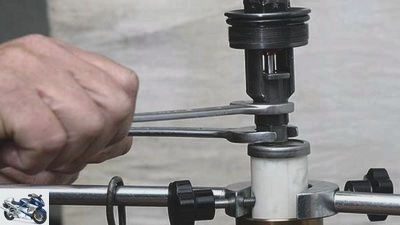
Schermer
counselor
workshop
Advice: change fork oil and springs
Advice: change fork oil and springs
Replace fork oil and springs
Because abrasion and wear also affect the fork oil and thus the damping behavior, a regular change is inevitable. However, this work is only recommended for technically experienced screwdrivers.
December 03, 2010
The further work after removing the fork legs is much more difficult. Therefore, occasional screwdrivers should better leave the maintenance or repair work on the telescopic fork to a competent specialist workshop.
Without special tools and screwdriver skills you should keep your hands off the fork.
First of all, a distinction must be made between two fork types. Older and simply constructed machines up to the beginning of the 1990s have simple systems in which the fork springs can be exchanged after opening the upper plugs and in which there are sometimes small drain plugs at the lower end of the immersion tube for changing the oil. So the fork legs can remain mounted in the fork bridges. In the case of more modern, so-called cartridge forks, on the other hand, there is much more effort involved, because the damper cartridge and spring are screwed as a unit to the upper fork plug. To loosen the screw connection, the pretensioned spring must be compressed using a spring retainer. This special tool is indispensable because anyone trying to overcome the spring force with a mounting lever and screwdriver will destroy the damper rod and the sensitive aluminum parts of the pretensioning mechanism. Spring retainer are sold by some motorcycle accessory chains and of course the relevant suspension specialists.
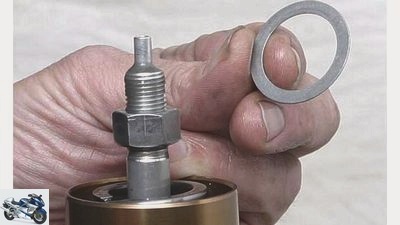
Schermer
Pay attention to the installation position of all components such as thrust washers or push rod.
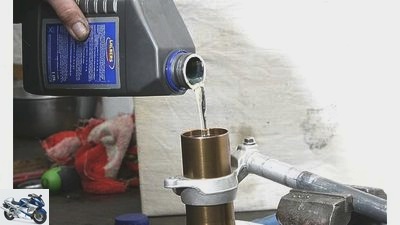
Schermer
The viscosity and the filling quantity of the fork oil determine the function of the damping and suspension.
Now the fork plugs, which were already loosened in the installed state, are unscrewed and the spring retainer is attached to the lateral holes in the spacer tube. A second man is very helpful when compressing the spring, because the nut of the damper rod, which is locked against the fork plug, sits under the sleeve. After loosening the fork stopper and then all components such as thrust washers, push rod or centering rings are removed and their order noted. Finally, the spring is pulled out of the spar and, like all other parts, deposited on a clean cloth or in an oil-proof plastic tray. In order to completely remove the old fork oil from the damper system, it is emptied upside down and the damper rod is moved up and down until no more hydraulic resistance builds up. In addition, you should let the fork drip upside down overnight to ensure that the contaminated oil, which tends to collect on the bottom valve, can also run out.
Rinsing with benzine or brake cleaner should be used with caution because residues could mix with the fresh oil. If you use this method, you should definitely blow out the fork with compressed air and let it air out in a warm room for two days. In the event of heavy abrasion and thick oil sludge, the fork must be completely dismantled and cleaned. Most of the time, plain bearings and fork seals (Simmerrings) are also worn out. Their replacement is described in MOTORRAD 8/2009.
Even the smallest dirt particles can paralyze the cushioning
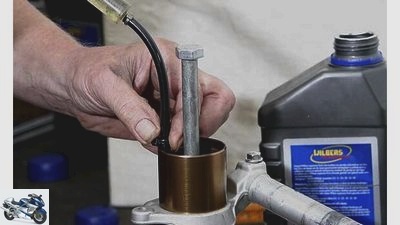
Schermer
Fill with fresh oil, vent the system and determine the oil level with a syringe.
After it is completely emptied, the fork leg is fastened in the vice again and the oil with the correct viscosity (see manual) is filled up to about 50 millimeters below the spring-loaded standpipe edge. To vent the system, the damper rod is then moved up and down over the entire stroke with slow movements. With some damper systems, the oil flows out of the top of the piston rod, which is therefore only allowed to be moved slowly. Before venting, the adjusting screw of the compression damping should be opened so that the damper insert can be moved with little resistance. If the cushioning system draws in air during this procedure, a little oil must be added. You can orientate yourself on the total filling quantity given in the workshop book. The actual filling quantity depends solely on the oil level, which determines the air cushion between the oil and the standpipe opening. This air cushion is measured after complete deflation with the damper rod submerged and in the fully “compressed” state. The progression that acts in addition to the suspension spring can be determined via the air cushion.
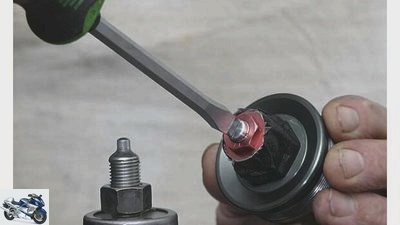
Schermer
The maximum damper clicks must be adjusted before assembly.
A large air cushion (around 130 millimeters) creates little, a small one (around 80 millimeters) a lot of additional “spring force”. In order to get to the desired level, the oil level is determined using a slide gauge / depth gauge. The fork leg should be vertical. A disposable syringe with a gasoline hose attached and a sliding cable tie or a pump provides valuable help in sucking out excess oil. When using progressive springs, the tight coils must be mounted upwards. Which has nothing to do with the spring action, but only serves to reduce the unsprung masses.
After installing the spring, washers and spring sleeve, the cleaned fork plug is screwed onto the damper rod. Before doing this, however, the clicks or turns of the damper adjustment screw must be adjusted. To do this, turn the screw counterclockwise and then set the number of clicks or turns in the opposite direction. If this step is forgotten, there will not be enough clicks after installation.
To prevent the damper rod from sinking during assembly, the compression damping at the fork base is completely closed. Then screw the fork plug onto the damper rod until the adjustment needle is in its seat with slight pressure. Tighten the lock nut in this position and then count the clicks / revolutions. Do not forget: After correct, the fork plugs in the stanchions must be tightened. Finally, the fork function is checked. The setting is checked for maximum and minimum damping force. A comparison of the damping force from one fork leg to the other is also a good way of checking the function. Then the original values of the damping and spring preload are adjusted.
More about technology
PS knowledge: technology
- Motorcycle technology clearly explained on 97 pages (PDF)
- From starter to spark plug
- Simple teaching of physical principles
- Tips and tricks for practitioners
To the PDF for € 9.99
#image.jpg
Related articles
-
counselor workshop Change fork sealing rings Change fork sealing rings Change fork sealing rings Loss of oil on the telescopic fork is not just a…
-
Advice: adjust springs and dampers
Schermer counselor workshop Advice: adjust springs and dampers Advice: adjust springs and dampers Tips for adjusting the suspension and damping On modern…
-
Schermer counselor workshop Advice: change fork Advice: change fork Remove and install the fork properly Simmerring leaking? Fork oil change due? Replace…
-
Chassis special: Part 2 – fork damping
fact accesories landing gear & Spring elements Chassis special: Part 2 – fork damping Chassis special: fork damping Front wheel damping – the dream setup…
-
Kawasaki 12th pictures Kawasaki 1/12 Current technical status: Kawasaki ZX 10R with 43 USD fork, Big Piston damping and relatively delicate triple trees….
-
Wilbers fork with adjustable progression
Pesamosca accesories landing gear & Spring elements Wilbers fork with adjustable progression Wilbers fork with variable progression “Fully adjustable” à…
-
Suspension special: Part 8 – fork tuning
Jahn accesories landing gear & Spring elements Suspension special: Part 8 – fork tuning Suspension special: fork tuning What are the real benefits of…
-
Schermer 8th pictures Schermer 1/8 The correct distance can be found in the manual. Use a lot of feeling when re-bending. Schermer 2/8 Above the spark of…
-
Ohlins NPX: The smart upside-down fork
Motorcycle fair in Milan EICMA 2021 Presented by Yamaha accesories landing gear & Spring elements Ohlins NPX: The smart upside-down fork Ohlins NPX The…
-
fact counselor Used purchase Used advice on naked bikes Used advice on naked bikes IG Druck und Metall The strong, undisguised displacement cars are also…